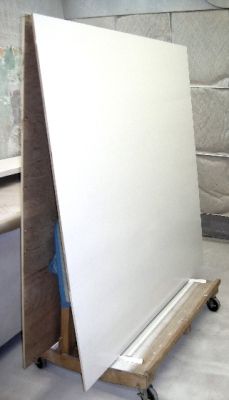Spraying Varnish on a Long Table
Overspray is causing trouble with large tables that are too big to reach across. Here, finishers discuss ways to prevent or repair the problem. December 15, 2005
Question
How do you get a continuous wet surface when spraying a table that is too large to reach across?
Forum Responses
(Finishing Forum)
From contributor F:
Be quick getting around the table. But if you're worried, retard the drying time.
From contributor M:
There are some ways to avoid over spray, which you are, I guess, afraid of:
1. Retard the material so that it won't get dry in the time you reach the other end.
2. As there is a retarder, there is a material that makes drying time longer - you can use that, too.
3. Begin spraying from far away from the room's air outlet fans to the closest - that way, the overspray material goes to the unsprayed area and you spray above it and avoid overspraying the dried area.
You don't have to be afraid of this problem on base coats, just at the last coat, be fast and work right. How big is the table?
From the original questioner:
They are 5'x9' conference tables and the overspray is killing us.
From contributor F:
Can you tilt the table so it cuts down on your reach?
From contributor D:
Are you using compressed air and precat?
From the original questioner:
Spraying Magnalax with a 2 gallon pot, conventional gun.
From contributor D:
I did a 5x12 table with my Kremlin and con varnish. It came out perfect, with no rubbing. You might want to put some butyl cellsolve in, turn the pressure down a little, and add a little thinner. The precat is drying too fast. Also, 40lb of compressed air is tougher to get an off-the-gun finish.
From contributor M:
You can always try to spray while the face is standing vertical, while it is 90 degrees to the fan, and begin from the far side. Every method has its problem. Practice methods on base coats.
From Paul Snyder, forum technical advisor:
The two main techniques I use have been covered. The first is to add a little retarder to the finish to slow its dry time. Then start spraying at the edge closest to you and lap each pass towards the center of the table. When you get as far as you can comfortably reach, go around the other side and continue where you left off toward the center. That way, you maintain your wet edge.
The other way is to use a jig or stand to hold the top at a steep angle so you can reach the whole thing easily. You can just prop the table at a steep angle while spraying it or make/buy a stand to hold it at the angle.
Here's an a-frame stand for spraying sheets of ply. Something similar could be used for table tops.

From the original questioner:
Thank you all so much. I am going to combine and try different methods - some I already have, and some are new.
From contributor K:
If over spray is your only problem, then you're in good shape. Try retarding your
lacquer a little to avoid dry lap, but when you're finished and there is still over spray, try this. Allow the top to cure overnight, hand sand the top with 600 grit sandpaper and a block. You must do this very uniformly. Sand in long strokes following the wood grain in the top. Next, hit the top with a fine scotch brite pad just as you did with the sandpaper. Clean the top with a dry cloth, then apply a fine coat of 100% lac retarder. This is called a melt. The retarder will melt the sanding scratches out of the top. Be sure to use the exhaust when spraying, for straight retarder is nasty stuff. When you're done spraying, turn off the fan for 20 minutes or so, because the retarder will keep the top wet to the touch for 10 minutes or longer, depending on how heavy your coat was applied. Try this on some samples first. If it's done right, it works really well. Remember - the sanding is the key. The surface needs to be sanded almost as if you were hand rubbing a satin sheen on a piece of furniture. This melt system works for everything and has helped me out
of some jams.
From contributor M:
You can always rub the finish with thinned wax, and sand it to the sheen you desire, but it is hard work - better to get it right with spraying the top coat and sending it to the costumer after that. If it is a lacquer base topcoat, the method contributor K described would work. With varnish it would not work well - varnish doesn't melt well after curing.
